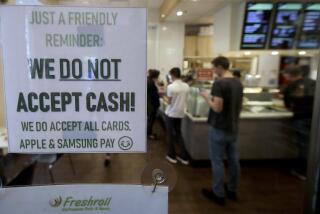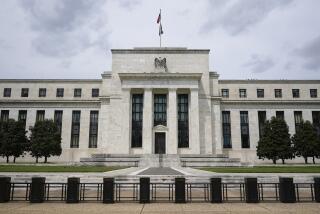Congress grapples with evolution from paper to mobile money
WASHINGTON — When Abraham Lincoln allowed the Treasury to print money for the first time in the depths of the Civil War, it was a major innovation born of a pressing reality.
The Union was broke.
Now, 150 years later, in admittedly less dire circumstances, Congress is preparing itself for the next big thing when it comes to money — a future in which payments are made with a wand-like wave of a phone rather than the exchange of wrinkled pieces of paper.
“We are, I think, on a precipice of some fundamental change in the way money is exchanged between consumers and businesses,” Rep. Shelley Moore Capito (R-W.Va.) said as she opened the first of a string of hearings in March.
Federally backed paper money allowed the Union to keep fighting the war after the government had burned through its coin reserves and a massive loan from banks, and had been reduced to writing IOUs to pay soldiers.
The greenback government notes, initially conceived as an emergency measure, quickly gained acceptance, with soldiers seeing it as their patriotic duty to spend them. But paper money is a 19th-century technology that has barely changed in 15 decades. Since the mid-1990s, cash has been in decline, according to a Federal Reserve estimate.
It now faces stiff competition not only from credit cards but from smartphones that promise businesses a way to advertise to customers before they pay or to offer them coupons, sort of like printing a little ad next to George Washington’s face or bumping up the value of a dollar bill to a dollar and 15 cents.
“The mobile device becomes a new marketing channel for merchants to use,” said Randy Vanderhoof, executive director of the industry group the Smart Card Alliance.
The Federal Reserve found in March that 12% of cellphone users had already made a payment through their phones. The same month, almost two-thirds of technology experts surveyed by the Pew Center on Internet and American Life said they expected mobile payments to eclipse cash and credit cards by 2020.
Last year, Google started Wallet, one of the most promising demonstrations of mobile money. It works by linking a phone to a credit card or a prepaid debit card. To pay in a store, a customer just passes his phone over a reader at the checkout, sending the information using a technology called near field communication, or NFC.
Google partnered with Sprint, and AT&T;, T-Mobileand Verizon teamed up and planned to start their own NFC-based system called Isis this summer. Apple and PayPal are expected to offer ways to pay by phone too.
Although the attention of the country’s biggest tech and wireless companies signals a watershed moment for mobile payments, members of Congress and regulators grappled at the hearings with how to make sure the competing systems played nicely together.
Richard Oliver, a retired executive at the Federal Reserve Bank of Atlanta, advocated an “open mobile wallet” that could be stuffed with just as many credit cards, receipts and store cards as a real wallet.
Serious questions about security and privacy need to be answered. There are concerns that hackers could siphon off money without customers noticing.
“The bottom line is that as the mobile payment system evolves it is important … to provide proper oversight so that these payments can be secure and convenient,” Sen. Tim Johnson (D-S.D.) said in March.
Wendell Wolka, a historian and collector of money, points out that a “cashless society” has been predicted for decades. Despite its limitations, cash offers privacy and is likely to be accepted by anyone, even in the middle of a blackout.
There may also be ways for cash to live side by side with mobile money.
Frustrated by what he considered to be the dull appearance of U.S. paper money, Richard Smith, a creative director at the marketing firm Sullivan, set up the Dollar ReDe$ign Project and received beautiful new designs. But, he said, “The most interesting ideas I got were those that went beyond traditional currency.”
For example, one submission proposed an elegant balance between paper and electronic money. It involved bills printed at home that could also be scanned into a digital account using a phone.
Yasmina Haryono, a Berlin interaction designer on the team behind the idea, said she wanted to give people complete control over their money.
When it comes to money, Haryono experienced her own innovation born of a pressing reality when stuck in a snowbound ski resort with a group of friends, many of whom had no cash. They were a mile from the nearest ATM and had no way to buy a drink.
The solution was a glimpse of the future: A friend turned himself into an ATM, trading cash to people who emailed him money using PayPal.
More to Read
Inside the business of entertainment
The Wide Shot brings you news, analysis and insights on everything from streaming wars to production — and what it all means for the future.
You may occasionally receive promotional content from the Los Angeles Times.










